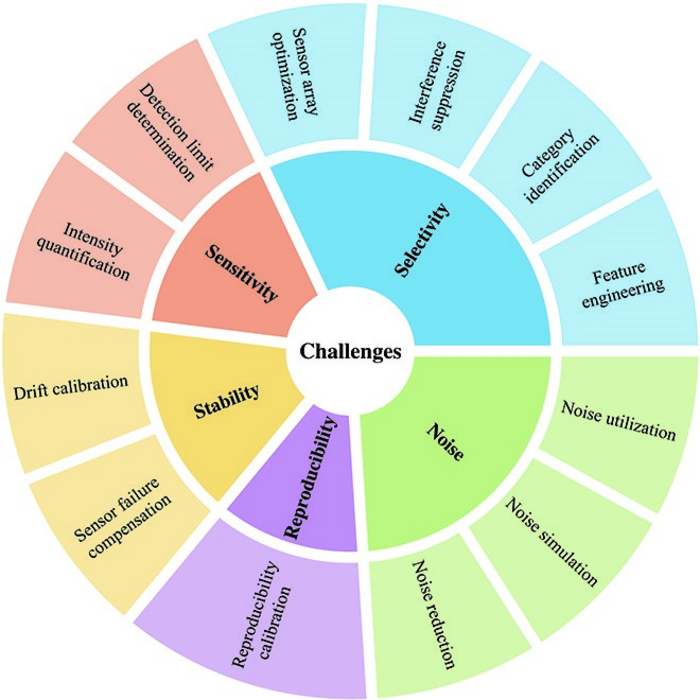E-noses are systems that integrate signal processing, chemical gas sensors, and machine learning algorithms to copy the sense of smell. E-noses could be used for many purposes, like monitoring air pollution, checking food quality, detecting explosives, and diagnosing diseases. The study questions their work along with the difficulties and opportunities in this field.

Overview of methodology categorization. The text in the inner circle refers to the sensor limitations, and the text in the outer circle refers to the methods and algorithms that deal with those limitations. Image Credit: Taoping Liu et al.
Recently, a research group headed by Jingdong Chen of Northwestern Polytechnical University in Xi’an, China, and Weiwei Wu of Xidian University in Xi’an, China, have explored such questions in an extensive review of the techniques and algorithms that have been specifically developed for e-noses. The review debates the restrictions of present gas sensors and offers a perspective on algorithm design.
The study was reported in the journal Intelligent Computing, a Science Partner Journal, on January 20th, 2023.
E-noses have the potential to mimic the biological sense of smell artificially. The gas sensors of the e-noses match the biological olfactory receptor neurons. When one sniffs something, small molecules float via the air and make an entrance to the nose.
In the same way, a gas sensor has the potential to capture airborne molecules via an air intake system. The sensor reacts to such molecules and alters them in a way that could be quantified by electronic signals. Furthermore, such signals are transformed from an analog format to a digital format so that computers can make use of algorithms to examine and interpret the data.
The present methods and algorithms in the field of e-noses have been summarized by the review, grouping them as per the classification framework that emphasizes the difficulties presented by the subsequent limitations of gas sensors:
- Limitations on selectivity. On exposure to an odorant mixture, gas sensors react to all stimuli in the mixture, thereby making it hard to differentiate different odors. Also, they may be impacted by nontarget odors, and various sensors might respond differently to the same chemical stimulus.
- Limitations on sensitivity. Every gas sensor functions within a range specified by the minimum and maximum quantity that can detect. Few are highly sensitive compared to others, but the range of a specific sensor is not known all the time. Also, sensors change in their potential to precisely detect odor concentration.
- Limitations on stability. Gas sensors frequently do not produce a firm and reproducible response to the same chemical stimuli as a result of material aging, sensor failure, or environmental changes.
- Limitations on reproducibility. Two gas sensors of a similar type might have various responses to the same gas under the same conditions.
- Limitations on noise. Gas sensors are impacted by external and internal noise. Sources of external noise consist of turbulence of airflow, background odor variation, and changes in humidity, temperature, and pressure in the encircling environment. Internal noise comprises noise produced by the measurement circuits and the sensors themselves.
During the past few decades, despite the considerable advances made, the large-scale deployment of e-noses in practical applications still has much to do.
For future research and development, the authors of the review think that guaranteeing the robustness of e-nose systems must be a top priority. While odor identification and intensity quantification have been extensively examined, various crucial tasks demand increased attention.
These include optimization of sensor arrays, detection of sensor drift and failure, interference suppression and recognition, noise reduction and utilization, and identifying the limit of detection, among others.
The researchers say it is significant to delve into the basic mathematical model of the sensing mechanisms, which is known to be the basis for resolving several problems connected to e-noses.
The study authors are Taoping Liu, Chen Su, and Weiwei Wu of Xidian University, Xi’an, China, Lihua Guo, Mou Wang, and Jingdong Chen of Northwestern Polytechnical University, Xi’an, China and Di Wang and Hao Dong of Zhejiang Lab, Hangzhou, China.
This study was financially supported in part by the Open Fund of the State Key Laboratory of Optoelectronic Materials and Technologies (Sun Yat-sen University), the Open Fund of Zhejiang Lab, the Fundamental Research Funds for the Central Universities, and Key Research and Development Program of Shaanxi.
Journal Reference
Liu, T., et al. (2023) Review on Algorithm Design in Electronic Noses: Challenges, Status, and Trends. Intelligent Computing. doi.org/10.34133/icomputing.0012.
Source: https://spj.science.org/journal/icomputing